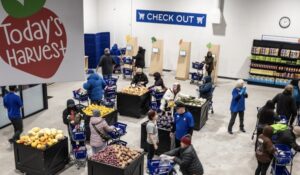Food banks, which have already risen to the challenge of assisting furloughed federal workers, now face a potentially much bigger shutdown-induced problem: extra demand for food from people facing longer-than-usual gaps between their monthly SNAP payments.
When the government resolved a potential disruption in SNAP by issuing February benefits early, it set up a new complication: a gap of more than 40 days until March SNAP payments for about 30 million people, according to a report from the Center for Budget and Policy Priorities. Worse, about 8 million of those could experience a gap of more than 50 days.
Although SNAP recipients are getting the same amount of money over the two months that they normally would, human nature dictates that the money they receive early will be spent quickly, setting recipients up for a very lean period toward the end of February and into March. The sheer volume of people facing stretched-out SNAP payments has food banks bracing for overwhelming demand.

In New York City, for example, 90 SNAP recipients will be impacted by the SNAP gap for every one furloughed worker, according to the Food Bank for New York City. “While the government shutdown may be over, the worst is yet to come for the many New Yorkers who rely on SNAP to help put food on the table every day,” Margarette Purvis, president and CEO of Food Bank for New York City, said in a statement. She added that a six-week gap between SNAP payments in New York “will place additional strain on emergency food providers across the five boroughs.”
In Seattle, Food Lifeline is already facing a food deficit because of its efforts to help furloughed workers. Now, to replenish its shelves as well as prepare for the SNAP gap, it is striving to increase the amount of food it distributes to area food pantries and meal programs by 20%, or 75,000 meals.
With a task team comprised of the leaders of each department, Food Lifeline came up with a multi-point plan to reach its 20% goal. It is adding 10 to 12 temporary employees, primarily warehouse workers and drivers, and leasing an additional three to four trucks to add to its fleet of about two dozen, said Mark Coleman, senior media and marketing officer. In addition, its food resources team is reaching out to food donors, particularly produce retailers, to encourage them to temporarily expand their donations.
With the added resources, Food Lifeline expects to be able to deliver food to more pantries than it normally does. To encourage groups to distribute more food, perhaps through pop-up venues, it will also waive all the nominal delivery fees it usually charges. The amped-up delivery plan has no end-date. “We’ll keep it up as long as we need to, if we continue to see low levels of inventory or higher need,” Coleman said.
Food Lifeline is raising funds to pay for all its extra effort, and donors are responding to its take-charge attitude. Coleman noted that the millennial employees of Amazon and Microsoft who populate Seattle represent a new breed of donors. “They don’t like donating to charity, they like investing in solutions,” he said, which is what Food Lifeline is offering.
Food Bank of Delaware’s solution to the SNAP gap features pop-up food distributions, including a massive drive-through pantry it assembled February 8, on a church parking lot. Families stayed in their cars while volunteers from a local utility loaded food from dozens of pallets into vehicles. In only two hours, the operation served 249 families. The extra distribution was one of three the food bank planned for February.
The food bank leased about a dozen trucks to transport the food, tapping into funding it received from Feeding America through its shutdown relief effort, said Kim Turner, communications director. The bulk of the food distributed came from a bounty received through the government’s plan to help out farmers affected by global trade policy. (Over the next year or so food banks are expected to receive more than double the 700 million pounds of food that typically flows annually from the USDA.) “We do have extra product to meet the extra demand,” Turner noted.
The food bank will need all the product it can get to continue to assist the state’s 136,000 SNAP recipients. (That compares to only 500 furloughed workers who came through Delaware’s charitable food system during the shutdown, Turner said.)
One bright spot is that Delaware, like many states, has elected to issue March SNAP benefits early, rather than spread the issuance throughout the month as it typically does. “People are definitely experiencing a crunch, but it’s better than it would be if they staggered the March benefit,” Turner said.
CAPTION ABOVE: The Food Bank of Delaware held a pop-up, drive-through food distribution to help people overcome the “SNAP gap.”









